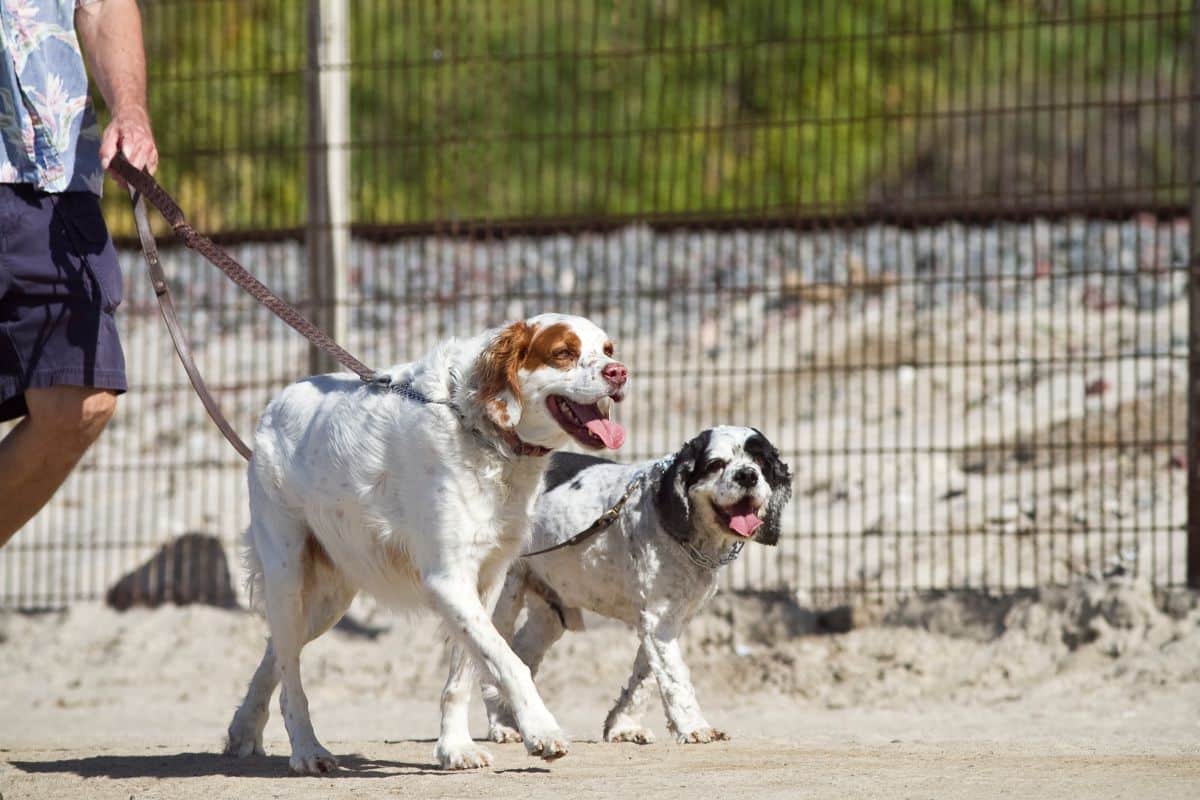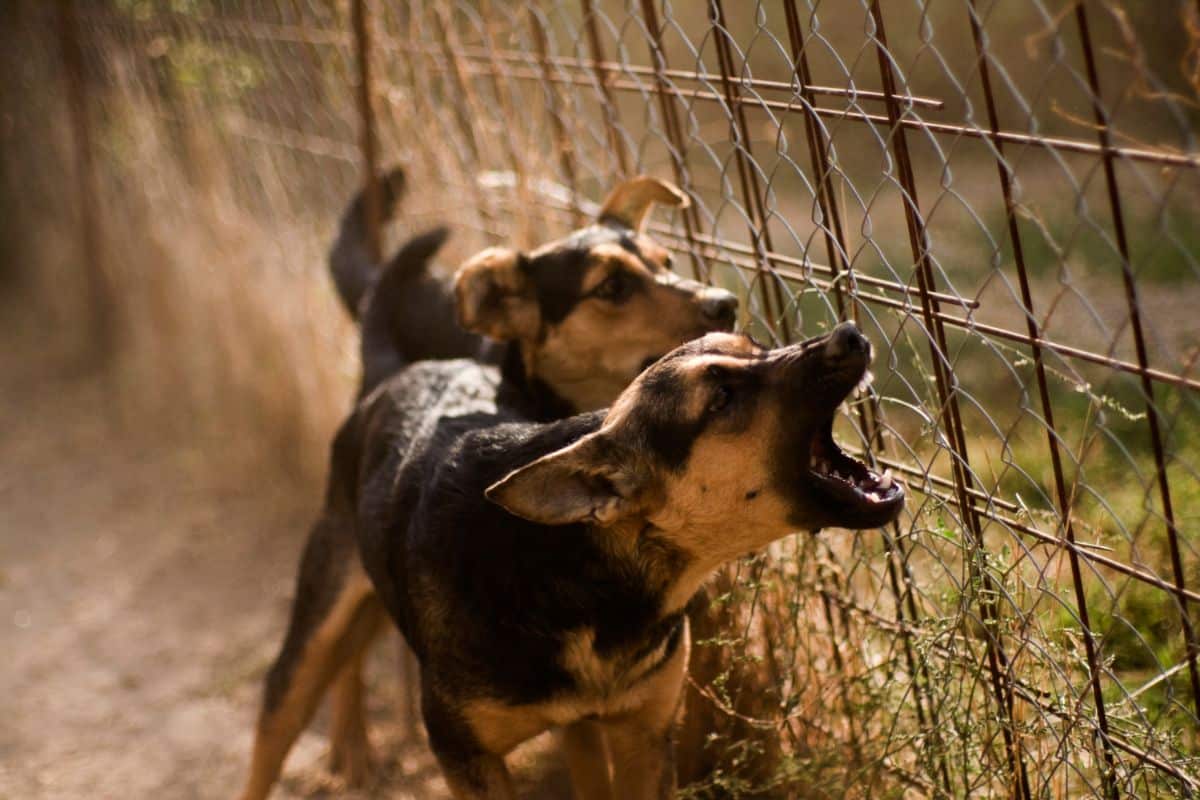The unfortunate truth is that fence fighting is incredibly common among dogs, even for those that are a lot smaller in stature.
It can be caused by many different factors, however, it usually comes down to a dog being territorial due to the anticipation of a possible threat which is usually caused by the sight or even just the sound of a dog next door.
However, while it is a common occurrence, it can end up causing both physical and mental harm to your dog while also leading to your fence becoming badly damaged in the process which is never ideal if you’ve been adding some new additions to your back garden.
Luckily, there are many ways you can prevent your dog from fence fighting so that you can keep both them and your back garden safe without having to worry about any other dogs spooking your canine companion.
Why Do Dogs Fence Fight?
Fence fighting is when a dog becomes anxious about someone or something they spot through a barrier that causes them to become agitated and aggressive.
This agitation often leads to the dog barking loudly (see also ‘Dog Barking At Sounds‘), growling, snarling, aggressively scratching the fence and sometimes even trying to jump over it.
Fence fighting is a little different than when a dog is simply whining near a fence in order to grab another dog’s attention, instead, the dog is a lot more aggressive and stressed when they are fence fighting which can easily lead some to assume that this is due to a dog turning violent for a few moments and wanting to attack another dog, however this isn’t necessarily true.
Fence fighting is more due to the dog being territorial and their anxiety that a potential predator is on the horizon. The limited vision and physical restriction of a fence also can make a dog more irritated since they can’t get a clear view or interact with the dog that they have spotted through the fence.
This restriction is also why a sudden bark from another dog or even the sound of a dog sprinting around can cause one to start fence fighting since they can easily become paranoid about a potential threat that they can’t see.
While fence fighting is therefore mostly about the dog being territorial, other common causes include becoming triggered by fast movements as many of the herding breeds are, along with becoming frustrated with the barrier or fence itself which can annoy them if both dogs are trying to interact.
Why Fence Fighting Is So Dangerous
Fence fighting is dangerous to a dog both physically and mentally, so it’s always important to take immediate action if you notice that it’s becoming a common occurrence.
Not only will it tremendously raise their stress levels while outdoors, but it can also cause them to develop a fear of sudden noises and movements along with other health issues including excessive eating and loneliness.
Because dogs will also tend to scratch and even bite the fence in an effort to get through it, it can also lead to them being covered in bruises, scratches and scars along with damage to their teeth and bleeding.
Even worse is if one of the dogs does manage to tear through the fence and engage in a physical altercation with the other which can lead to them becoming severely injured and scared to approach other dogs in the future.
It can also have the opposite effect of making the dog more worried and anxious about others which can lead to them acting more aggressively than they would normally.
To ensure your dog is safe and healthy, it is therefore important to always take immediate action as soon as you notice any fence fighting occurring in your back garden, and luckily, there are a few ways to stop it from happening.
Ways To Prevent Fence Fighting
While buying a new fence altogether is definitely a viable option, there are a few other ways you can prevent your dog from fence fighting which can be a lot less expensive and time-consuming and are always worth considering to encourage your dog not to engage in it in the future.
Here are some of the most efficient methods.
Obedience Training
An easy and efficient way to try and dissuade a dog from getting too paranoid or aggressive once they spot another dog through the fence is through commands.
As long as the dog has grown close enough to its owner, it will always follow their commands which is incredibly useful when you notice that your dog is peering through the fence or pacing around it to start a fight.
If you do spot this, the classic ‘sit’ and ‘stay’ commands can help notify the dog to stop what they’re doing and to not get any closer to the barrier. Additionally, you can also teach them the ‘Come’ command so that they stay close to the owner rather than drifting towards the fence.
This type of dog obedience training helps to keep the dog aware of what they should and should not be doing, so using them anytime your dog even gets close to the fence can teach them not to engage in fence fighting down the line.
Playful Distractions
Whether it’s an interactive toy that lights up when it’s touched or just an everyday stick you found in the garden, when a dog is active they love nothing more than playing around with a toy along with their owners which is what also makes them an extremely useful distraction if you ever notice your dog creeping towards a fence with a less than pleasant look on his face.
It’s important to throw this distraction quickly and proactively since dogs can very easily redirect their attention if they hear or see something they like the look of, so the best tactic is saying the dog’s name and throwing the stick or toy for them to collect as soon as they start wandering near the fence.
Interactive toys that make loud and high-pitched noises are often the best toys for this job since they are guaranteed to catch the dog’s attention, however, this will need to be done before the dog engages in a fence fight since when they are in a frenzy it can be much harder to redirect their attention.
Take Both Dogs For A Walk

Just like us humans, dogs a lot of the time fear what they don’t understand and when another dog is roaming around so close to their territory, it can make the dog confused, anxious and eventually aggressive, which is why letting both dogs get to know and understand each other is actually an incredibly effective way of getting them out of the habit of fence fighting.
When it’s time to take your canine companion for a walk, try asking your neighbour if they would care to join you so that the two dogs can get to know each other on a more personal level.
This will desensitize the dogs to each other and teach them that there is nothing to be afraid of which will stop them from having so many stare-offs through the fence.
For this to work, both dogs of course will need to actually get along with each other since if one is too hostile or aggressive to the other, it can only make things worse, so it’s always worth explaining the situation to the neighbours first and asking them how friendly and cooperative their dog usually is.
Practice With A Leash
While a back garden is an area for a dog to freely stretch its legs and enjoy some freedom in the outdoors, leashes are a great way to teach your dog where they can roam and which areas of the garden they are better off avoiding including the fence.
To do this, simply attach a leash to your dog’s collar and let them roam around the garden while staying fairly close to them. Be sure to observe where they go, if they immediately drift near the fence then you can slightly pull the leash and signal for them to come back to you.
If they do return back to you or if they begin adventuring around other parts of the garden such as around a shed or in some bushes, reward them with a treat or by rubbing on their head and back so that they know where they are expected to go.
Doing this just a handful of times in a row will train the dog to move in a certain direction when they enter the garden and is an excellent solution for dogs that will immediately dart over to the fence once they’re let out.
Communicate With Your Neighbour
It’s very rare that fence fighting is ever a one-sided ordeal as usually, both dogs will start getting fired up and aggressive once they spot each other through the barrier.
You can therefore be sure that your neighbour will want to put an end to the issue just as much as you do, so it never hurts to talk with your neighbour and brainstorm ideas of how to prevent the dogs from getting flared up when they see each other.
One obvious way is to learn when your neighbours are most often to let their dog out their back garden since if you know what time they usually do this and for how long, it means you can let your own dog out outside of this time slot so they won’t have to see them entirely.
Build A Solid Fence
Part of the reason dogs become so aggressive and agitated during a fence fight is not only because of the animal on the opposite side, but also because of the fence itself which usually has gaps in between or is made using a chain link which gives the dog partial vision of the garden next door.
A simple way to remedy this if you’re struggling to convince your dog away from the fence is to use a solid fence so that the dog’s vision is completely blocked off, along with using thick hedges and bushes to cover up any potential cracks or sightlines.
If you do decide to use a solid fence, it’s crucially important you also make it as high as possible since if your dog can hear that something is behind the fence but can’t see it, they will attempt to jump over instead.
Vinyl fences are actually one of the best options for this since they will often have no gaps in between each layer while also being incredibly durable since they are 5 times stronger than wood and are at a much lower risk of rotting, splitting or warping.
Hire A Professional Trainer
If all else fails and after trying to distract your dog they still try and race towards the fence, it never hurts to get into contact with a professional dog trainer who will work directly with your dog and can teach them to ignore others if they ever see them as well as encouraging them to focus more on exercise, toys and their owners as opposed to what’s going on next door.
Professional dog trainers are very accustomed to fence fighting with it being one of the most common reasons that many people will hire them, so you can be sure your dog will be in good hands from someone who has dealt with this issue many times before.
Frequently Asked Questions
Should You Scold A Dog For Fence Fighting?
You should never scold or punish your dog for fence fighting since it is not technically their fault and is more of a natural reaction that most dogs will have once they spot a potential predator through their fence.
Punishing a dog can only make them more irritable and distant from their owner which in the long run will make it much harder to train them yourself, so while you shouldn’t exactly praise them, instead try using orders as much as you can rather than shouting at them.
How Much Does A Professional Trainer Cost?
If you’re thinking about hiring a professional dog trainer to help put an end to your fence-fighting problems, one-to-one sessions on average cost between £40 – £80, though this does depend on the quality of the trainer and what they will be teaching your dog.
Summary
Try out a few of these methods to encourage your dog to stop peering through the fence so that they can feel safe and comfortable in their own territory without having to worry about any potential intruders.





